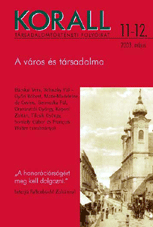Nagyszombat, 1579–1711. A város területe,mint elbeszélés
Nagyszombat (Trnava, Slovak Republic), 1579–1711. The Territory of the Town as Narrative
Author(s): György GranasztóiSubject(s): History
Published by: KORALL Társadalomtörténeti Egyesület
Keywords: social history; urban history; Hungary; 16-18th centuries; Trnava; maps; housing; dwelling; Baroque; local politics
Summary/Abstract: Approaches of traditional urban history and social history neither succeed in the joint description of the early modern survival of the medieval middle class community and the emerging baroque ecclesiastical–university world, nor are they capable to cope with the fact that the economic decline of Trnava went hand in hand with a matchless cultural and architectural rise. The digital maps produced on the basis of tax inventories show that the number of houses did not vary equally on the territory of the town. The western part of the town hosting the Trnava middle class elite seemed to be shifting, the emergence of eastern ecclesiastical –university centre was accompanied by social change, and the new and complex unfolding of poverty (not examinable by economic categories only), was especially spectacular after the appearance of hovel rows clinging to the town walls – while unique stability characterized the bourgeois middle class house rows along the brook. Other observable changes on the maps show the working of authority and political power mechanisms that shaped the territory of the town. Public buildings do not simply represent political power though. Ecclesiastical and worldly, middle class and church authorities strove with varying success to articulate themselves and (on real or symbolic terms) to appropriate one or the other spot of Trnava territory in the 16th–17th century. Variation gives expression to political changes occurring on the territory occupied by town dwellers. The transformation of middle class autonomy, the fall of Protestantism and the victory of the Baroque characterize these changes. From the analysis the following consequences can be drawn. Firstly, the unique process of segmentation signalled by the varying quantity of houses had been going on since the 16th century on the territory of Trnava. On practical terms this means on the one hand the increase of difference between houses of poorer and better quality, on the other the decrease of homogeneity in the distribution of houses of similar value. This resulted in a greater variety of modest and valuable houses in the townscape. The appearance of shanty houses demonstrates the loosening of the relative homogeneity of the medieval middle class community. A further consequence is that the appropriation of space by the middle class, namely the allotment system that framed urban living and gave expression to the essence of autonomy going back to the Middle Ages, did not change. This fact demonstrates persistence over ages.
Journal: Korall - Társadalomtörténeti folyóirat
- Issue Year: 2003
- Issue No: 11-12
- Page Range: 75-102
- Page Count: 28
- Language: Hungarian

